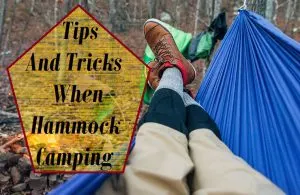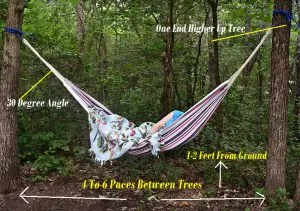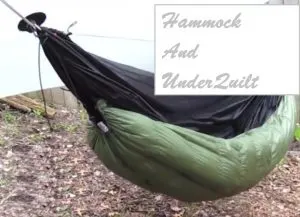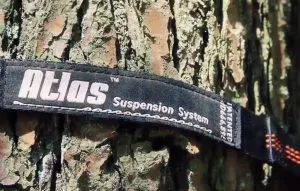 Hammock camping is the best way to cover ground and setup camp in the most obscure locations. Whether you are swinging in the trees or enjoying lightweight camping gear, using the humble hammock as a camping bed is one of my favorite ways to get away. Before we look at some of the most important hammock camping tips and tricks to keep in mind when setting out on a outdoors adventure, you need to ask yourself “Why”.
Hammock camping is the best way to cover ground and setup camp in the most obscure locations. Whether you are swinging in the trees or enjoying lightweight camping gear, using the humble hammock as a camping bed is one of my favorite ways to get away. Before we look at some of the most important hammock camping tips and tricks to keep in mind when setting out on a outdoors adventure, you need to ask yourself “Why”.
Why go hammock camping, isn’t it more riskier, especially if Mother Nature turns her back on you. What about bugs and creepy crawlies. No matter what you currently think, if you have never gone hammock camping before, your expectations will never surpass the actual experience. That is unless you are not prepared and follow these simple tips to survive.
Each and everyone one of you may have a different ‘Why’ you want to go hammock camping, but here are just a few of the more common reasons.
- Camping freedom. Having the ability to set up camp wherever there are two trees close together. Or if you have gone the extra mile and purchased portable hammock stands that fold down into a neat compact unit.
- Brings you closer to nature. Unless you are sleeping under the stars with no tent, a hammock is the most logical way to sleep if you want to be closer to nature.
- Very comfortable place to sleep while also acting as a camp chair or rest station to lay back and read a book.
- Great for fishing enthusiasts. You can set up right where you plan to catfish and continue on though the night. Have sleep when your tired and wake up to a waterfront view. Does it get any better?.
Tip #1. Get The Best Hammock You Can Afford
There are all kinds of hammocks available. Choosing one that is right for you is the best tip I can possibly give. After all, the hammock will be your bed for the night. With scout hammocks, travel, lightweight and jungle hammocks, how are you meant to know which is best for you.
When you know what you destination is and the expected weather forecast, choosing a hammock can be a little easier. Which I will go over into more detail below. But to get you started, you can follow this link and discover this years top rated camping hammocks.
Where To Hang Your Hammock
Taking the necessary precautions and planning ahead is essential. The most important thing will be an area that has trees within a suitable proximity to support the hanging beds.
Ideally you want to find good solid healthy looking trees with trunks that have a minimum diameter of 16-18 inches. This way you will know that the trees can actually support your weight and you also won’t damage the trees. Another tip for finding the ideal hammock camping location is to always look up. Make sure that you are not going to set up camp underneath a branch that is destined to land on your head with an increase in winds.
4-6 paces is a good distance between the two trees. This will mean you’re not too far nor are you too close to the hammock that it is impossible to set up. However, if you have line extenders than you can go further distances. Once you have found the ideal location, tie your ends around the tree. When leveraging your hammock into position, try to keep a 30° angle on each of the two lines. This will give you enough leverage to support your weight and not be too high up.
Handing Hammock Hanging Tip
When positioning your hammock on the two trees, try to have one end slightly higher up the tree. This will be the end where your feet go. If you have the two ends dead level, what tends to happen is you slide down towards your feet during the night. Which can be uncomfortable and ruin a good nights sleep.
Tricks To Insulating Your Hammock For Camping Conditions 
Furthermore, you will need to remember that hammocks provide very little protection from the elements and you may need extra warmth even in places that can be warm during the day. Choose a spot where wind is deflected enough to keep a safe fire lit throughout the night. Hammock underlays are a great idea if you are predicting cold winds. These underlays sit beneath your hammock and create a barrier form the wind. Keeping you all that much warmer. In addition to keeping you warm, a fire can really add to the soothing and relaxing experience of sleeping under the stars.
Adequate insulation is an important part of your planning for a successful trip. The dangers of heat loss and exposure are much greater when you are in the outdoors. The right insulation can keep you from being exposed to hypothermia. Some campers are more susceptible to the cold than others, but everyone will benefit from a sleeping pad in the hammock.
In addition to keeping you warm, this is more comfortable and will also perform well if you happen to be sleeping in an especially warm or humid jungle or rain forest. Having some lighter coverings will be a good idea, but don’t forget how quickly the temperatures can change.
How Low Should You Hang Your Hammock?
It is always best to keep your hammock no higher than a foot and half from the floor. A good rule of thumb would be to ask yourself how far you’d like to fall should your supports suddenly give way while you are sleeping. It can be difficult to ascertain the true support you are getting from a limb or tree, even sturdy trunks can suddenly come up at the root and give the camper a fear of the outdoors — don’t laugh, it’s happened!
Another good reason to keep a low height is that you will have better access to your camping gear and tools that will be stored nearby. Distances and spaces can be deceptive in the dark and you will avoid a host of accidents by keeping a low sag in your hammock. The only downside to laying low is wild animals can easily reach you. But hey, that’s the risk you take when hammock camping in the unknown.
As a footnote to this tip, clear the ground under your hammock from sharp rocks, thorny branches or shrubs and all poisonous plants as well — just in case.
Tips For Getting Into Your Hammock
- Position the height of your hammock so that it is not too high as mentioned above. I wouldn’t go any higher than a level in which you can easily sit down into the hammock .
- Stand in the center and grab the front of the hammock material. Bunch it up in on hand and pull it in behind your knees.
- With your other hand, grab the back side of the hammock material and pull it over you shoulders.
- Gentle sit down into the hammock. To lay down, simply swing you body around and position your feet at the higher end of the hammock and lay your head down.
The Ideal Position For Your Body In The Hammock
You will no doubt compile your own personal list of hammock camping tips and tricks for better comfort the more adventures you go on. But sleeping in a hammock can take some practice to achieve. It is not the most comfortable choice of sleeping arrangement if you don’t know what you are doing. But it is quite possible to wake well-rested in the morning if you sleep in the right position.
The aim will be to position yourself as diagonally as possible. Known as the ‘Diagonal Lay’. This causes the fibers to offer better support to your back and hips. Your feet can be a bit higher than your head and this provides and almost flat support from your hips to your head.
This is achieved by positioning your head on the opposite corner of your feet, remember your feet should be on the high end of the hammock. What this does is positions your body nice and flat. It also enables the side sleepers out there (hands up!, yes me) to sleep on their side while in a camping hammock. You twist your body so that you are on your side. Because you are in the diagonal lay position your head can rest on the raised side of the hammock without getting a fave full of material. Not only comfortable, but totally possible for side sleepers.
But remember, have one end of the hammock higher up the tree and hang the hammock with about a 30 degree suspension to obtain the best sleeping position ever.
Tips For Staying Dry
Despite the forecast, the chance of showers can be quite unexpected in some regions and it is always good to have a plan. Staying dry while hammock camping is what can make or break your camping trip. Don’t go ill prepared.
The hammock lacks the structure and protection found in a tent, but they can still protect you from light to medium showers. Hammocks can be equipped with a rainfly either as a optional extra or included in a hammock tent which is the ideal hammock for camping. This is because the hammock tent offers you protection from rain, wind and even mosquitoes.
The rainfly is a piece of water resistant and often hydrophobic materials that can be set over the tent to protect the sleeping camper from the rain. Another option would be a large tarp, these can be procured in a wide variety of sizes and strung up in a plethora of creative ways as the need demands. The most popular tarp used by hammock campers is the 3×3 because of its versatility.
Setting the tarp is quite simply. Using nothing more then a guideline tied to the two trees the hammock is on, you can create a nice triangular protection from rain. Tie the attachments to the rings in the tarp to keep it in position. If you think it’s going to rain immediately, set the tarp up before you hang the hammock.
Don’t Get Eaten Alive! Keep The Bugs Out
In addition to the threats of the elements, there are other terrors lurking in the dark. Insects of a great variety inhabit wooded areas and many of these have blood on their menus. Keep away these attacks with a convenient mosquito netting that is sold alongside many hammocks. This is especially important in avoiding many of the worst diseases transmitted by bug bites. From Lyme disease to Malaria, there are some things you just don’t want to bring home with you.
The mosquito and bug nettings are available as separate items to your existing hammock. They are pretty universal and can fit most hammocks suited to camping. As mentioned above in protection from the rain, a hammock tent with come with a pre installed mosquito net that offers 360° protection from bugs as small as the no-see-ums (those pesky little insects that are incredible small but super annoying.
Last But Important Hammock Camping Tip
Last but by no means least of these hammock camping tips and tricks, you will want to ensure your tether that suspends you in the air over night is made of the most durable materials. Webbing straps are the preferred option as they don’t break and their resistance is unchanged after repeated use.
Go for those made of polyester or polypropylene as these have the capacity to shift the weight distribution and retain their grip. These will also cause no damage to the trees and limbs from which you will hang your hammock.
Be sure to test the strength of your hammock straps before setting off on your trip. If they have been previously used, check for any fraying or signs of wear and tear. It might be time to replace them. If they are sagging too much or seem insufficient for the weight they will hold, you may need to pick up some new straps on your way out.
Practice setting up your hammock before heading outdoors. Find a couple poles, signs, car roof rack, basically anything so that you can get a grip on how to tie a hammock off. The last thing you want to do is find out as the sun is fading that you haven’t mastered the art of hammock hanging.

Anna Collins
Thursday 16th of June 2022
Since our backyard has been properly landscaped now, I was thinking of tying up a hammock so I can rest outdoors. It's great that you mentioned how it's advisable to have at least a minimum diameter of 16-18 inches between 2 healthy trees. I'll be sure to keep this in mind while I look for yard hammocks for sale.